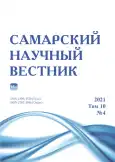Horse breeding in the Urals in 1922–1941
- Authors: Bakhtiyarov R.S.1, Fedorova A.V.2
-
Affiliations:
- Ilek Zootechnical College - branch of Orenburg State Agrarian University
- Orenburg State Agrarian University
- Issue: Vol 10, No 4 (2021)
- Pages: 172-176
- Section: Historical Sciences and Archaeology
- URL: https://journals.rcsi.science/2309-4370/article/view/104915
- DOI: https://doi.org/10.17816/snv2021104207
- ID: 104915
Cite item
Full Text
Abstract
This work aims to study the history of one of the most important branches of animal husbandry of the pre-war period – horse breeding. The processes taking place in horse breeding largely influenced the results of the development of the entire national economy of the country in the 20–30s of the 20th century and the Ural economic region in particular. Normalization of the situation in horse breeding in the late 30s increased the country’s military and economic capabilities in 1941–1945. After the end of the Civil War in the USSR the total number of horses by 1923 fell by almost 2 times compared to the level of livestock available in the Russian Empire before the outbreak of the First World War. On some territories of the Urals these indicators fell to a larger size. The economic security of the state was put at risk, since horse-drawn transport in the early 20s had virtually no alternative dominance in the country’s economy. Thanks to the measures taken, by 1929 the number of animals managed to return to the pre-revolutionary level – up to almost 35 million heads. But the processes of industrialization and collectivization that began, which changed the structure of both the country’s agriculture and the entire economy as a whole, contributed to a sharp displacement of horsepower and a reduction in livestock. If in 1929 the agricultural sector of the USSR was horse-drawn by 96,2% of the energy capacity, by the end of the 30s this figure did not exceed 23%. Therefore, the number of horses from 1930 to 1935 fell from 34,5 million heads to a little more than 14 million. Nevertheless, the leadership of the Soviet Union, realizing the ruinousness of such a policy, took a number of effective measures that allowed during 1935–1940 to stop the decline in the number of animals and achieve a significant increase in the number of livestock, which by the beginning of 1941 reached 21 million heads. These processes were also characteristic of the regions of the Urals, which during the Great Patriotic War became the most important source of horses for the Red Army and the national economy.
Keywords
Full Text
##article.viewOnOriginalSite##About the authors
Rustam Suleimanovich Bakhtiyarov
Ilek Zootechnical College - branch of Orenburg State Agrarian University
Email: rustam7174@yandex.ru
candidate of historical sciences, lecturer
Russian Federation, Ilek, Orenburg RegionAlla Vladimirovna Fedorova
Orenburg State Agrarian University
Author for correspondence.
Email: istogau@yandex.ru
doctor of historical sciences, professor of History and Philosophy Department
Russian Federation, OrenburgReferences
- Кожевников Е.В., Гуревич Д.Я. Отечественное коневодство: история современность, проблемы. М.: Агропромиздат, 1990. 221 с.
- История Великой Отечественной войны Советского Союза 1941–1945: в 6 т. Т. 1 / ред. комис. П.Н. Поспелов, В.А. Андреев, А.И. Антонов, И.Х. Баграмян, П.А. Белов. М.: Воениздат, 1963. 535 с.
- Декреты советской власти. В 2 т. Т. 1. 25 октября 1917 г. – 16 марта 1918 г. М.: Госполитиздат, 1957. 626 с.
- Собрание узаконений и распоряжений правительства за 1917–1918 гг. М.: Управление делами Совнаркома СССР, 1942. 1483 с.
- Каракулов Д.В. Голод 1921–1922 гг. на Урале: автореф. дис. … канд. ист. наук. Екатеринбург, 2000. 24 с.
- Статистический справочник Оренбургской губернии. Оренбург: Орен. губстатбюро, 1925. 184 с.
- Статистический справочник по Уральской губернии. Вып. 1-й. Уральск: Урал. губстатбюро, 1925. 106 с.
- Малигонов А.А. Исследования по коневодству Сибирского края в связи с некоторыми вопросами коневедения. М.: Новая деревня, 1927. 214 с.
- Грыць-Апостол. Изучение и рационализация работы тяговых животных. М.: Сельхозгиз, 1933. 96 с.
- Алтухов П.Г. Лошадь. Сельскохозяйственное коневодство: руководство для сельских хозяев. Л.: Мысль, 1929. 464 с.
- Конские ресурсы СССР: сб. статей. М.: Сельхозгиз, 1939. 488 с.
- Федорова А.В. Наш гость Буденный // Блокнот агитатора. 1983. № 9. С. 30.
- Коннозаводство и конный спорт / под ред. проф. Ю.Н. Барминцева. М.: Колос, 1972. 319 с.
- Филатов В.В. Уральское село, 1927–1941 гг.: динамика и темпы развития животноводства. Магнитогорск: ГОУ ВПО «МТТУ», 2006. 264 с.
- Данилов В.П. Советская доколхозная деревня: население, землепользование, хозяйство. М.: Наука, 1977. 318 с.
- Филатов В.В. Развитие животноводства на Урале в дореволюционный период и в 1920–1930-е годы: сравнительный анализ // Аграрная экономика в контексте российских модернизаций XIX–XX веков: эволюция и кризисы: сб. статей. Оренбург: Изд-во Регион. центра развития образования, 2009. С. 377–380.
- О мероприятиях по развитию коневодства // Собрание законов и распоряжений рабоче-крестьянского правительства Союза Советских Социалистических Республик. 1931. № 58.
- Бахтияров Р.С., Федорова А.В. Животноводство на Южном Урале в условиях Великой Отечественной войны 1941–1945 гг.: монография. Оренбург: Изд. центр Оренбург. гос. агр. ун-та, 2019. 208 с.
- Буденный С.М. Машина и конь – верные помощники колхоза. М.: Партиздат, 1934. 40 с.
- Бахтияров Р.С. Конь для армии: оценка использования в военных целях в первой половине XX века // Воспитание и обучение истории в школе и вузе: исторический опыт, современное состояние и перспективы развития. Ежегодник. XX всероссийские историко-педагогические чтения: сб. науч. ст. Ч. I. Екатеринбург, 2016. С. 99–106.
- О государственном плане развития животноводства по СССР на 1935 год // Правда. 1935. 28 апреля. С. 1–2.
- Мотревич В.П. Сельское хозяйство Урала в показателях статистики (1941–1950). Екатеринбург: Наука. Урал. отд-ние, 1993. 306 с.
- Оренбургской области – 40 лет. Оренбург, 1974. 36 с.
- Илекский районный муниципальный архив (ИРМА). Ф. 8. Оп. 1. Д. 148.
- ИРМА. Ф. 8. Оп. 1. Д. 152.
- Российский государственный архив экономики (РГАЭ). Ф. 9481. Оп. 1. Д. 1200.
- РГАЭ. Ф. 9481. Оп. 1. Д. 1237.
Supplementary files






